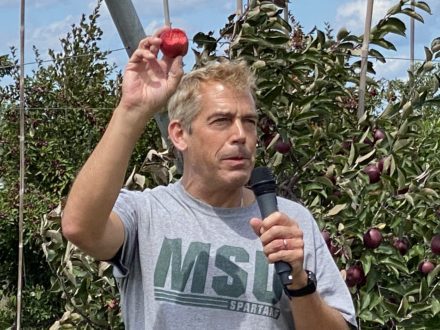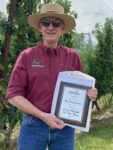

Aug 5, 2022Ridgefest updates industry on Michigan apple, cherry research
As old apple orchards are removed to make way for more valuable cultivars, apple replant disease can be an issue causing early decline of trees planted into old orchard ground.
Replant disorder occurs when new trees are planted where old trees once grew. The big root systems left behind in the soil can support huge amounts of fungi and pests, including nematodes and pathogens – all of which might suppress the growth of the new trees.
Replant disorder has yet to have a widespread impact in Michigan, and researchers from Michigan State University (MSU) are working to keep it that way. Their project is evaluating seven varying pre-plant treatments and two different apple rootstocks to determine which combinations result in better soil and tree health and productivity in Honeycrisp apples.
Preliminary findings of the work were presented July 28 as Michigan Pomesters had its 11th annual Ridgefest field day, touring research trials at MSU’s Clarksville Research Center. The presentation was one of several reviews of emerging best practices for tree fruit producers.
MSU tree fruit specialist Julianna Wilson indicated replant disorder stems from particular soil and environmental conditions. The project at Clarksville began in 2017 with pre-plant treatments applied in 2018, and the new orchard planted in the spring of 2019.
Soil testing was done to characterize the microbial community and measure soil health. Measurements of tree vigor and productivity were collected, including the first harvest in 2021 and an assessment of bitter pit.
Highlights of results
According to research on rootstock and treatment effects:
- Trees on G.214 surpassed the top wire in the third leaf; trees on B.9 are noticeably shorter than the G.214 across all plots; however, both rootstocks produced slightly taller trees in the rows that overlap the old drive row than those that overlapped the tree row.
- Cover crops planted in the interval year provided a slight boost in B.9 tree height.
- More fruit were produced on trees on B.9 by the third leaf than on trees on G.214; however, average fruit weight did not differ between the rootstocks, and there was no difference in fruit color at harvest.
- Frequency of bitter bit was highest in “immediate replant” plots and lower when cover crops had been used in the interval between orchards.
Researchers reported that below-ground effects include:
- It appears the greatest difference across treatments for nematodes were in the year in which the pre-plant treatments were implemented; also, in that year, Wilson said they saw some differences between old drive lanes and old tree rows. Researchers are still working on summarizing the results of the soil microbial community.
- Cover crops planted in the interval year showed the greatest positive impacts on most measures of soil health.
The rapid transition from older, low-density orchards to newer, high-density orchards in Michigan offers the potential for apple replant disease to proliferate, Wilson said. Small, modern trees on vigor-suppressing rootstocks are more likely to be sensitive to replant disorder.
A full summary of the apple replant research findings will be presented at the Great Lakes Fruit, Vegetable & Farm Market EXPO in December.
Evaluating cherry growing systems
Several updates of ongoing research projects were presented to Ridgefest tour visitors.
Horticulture professor and cherry specialist Greg Lang outlined his findings regarding planar sweet cherries, a training system architectural approach that Lang anticipates will achieve widespread grower adaptation in years to come.


“This is kind of the culmination of 20 years of various kinds of trials. Every new trial, we try to make incremental progress,” said Lang, who was presented a plaque for being the Michigan Pomesters’ 2022 Fruit Person of the Year for dedicating much of his tenure at MSU to the tree fruit industry.
Lang emphasized that he has found the Upright Fruiting Offshoots (UFO) system had yields that matched or exceeded tall spindle axe, super slender axe and Kym Green Bush. Of the four systems, UFO was also the most labor-efficient for pruning and harvesting. Subsequent trials studied various iterations of UFO, including as a single vertical plane or a dual angled plane, Lang said.
The use of planar canopies for sweet cherries can lead to high labor efficiencies and mechanization advantages. A decade from now, all progressive cherry orchards will have planar architectures, Lang said.
Cider and red apple juice
MSU horticulture professor Steve van Nocker outlined the red-juice apple development and evaluation program and the Great Lakes Cider Apple Collection efforts that are ongoing at Clarksville.
The hard cider industry is quickly expanding in Michigan and elsewhere in the U.S. Van Nocker said growers have little information available as to what cultivars are available, which ones might produce well under Michigan conditions, and what qualities the juice might have.
The MSU Great Lakes Apple Cider collection is an ongoing trial of traditional hard cider cultivars. Initiated in 2016, the collection now represents 88 cultivars. Trees are grafted onto Pajam-2 rootstock and planted at six feet apart in 10-foot rows, with 10 trees per cultivar.
“Over the next six to 10 years, we will be evaluating these cultivars for suitability of production under Michigan conditions,” van Nocker said. “We will also evaluate disease, vigor, alternate bearing, tree architecture, pre-harvest drop and fruit juice quality, including yield, juice TA (titratable acidity), pH and brix, and phenolics content.”
He said new cultivars are added each year, as poorly-performing cultivars are removed.
“The goal of the project is to provide reliable information to Michigan apple growers to select the most suitable and profitable cultivars for hard cider making,” van Nocker said.
Red-fleshed apples are also on van Nocker’s radar. Some non-commercial apple cultivars produce red juice, which could be used for hard cider, juice products, natural colorants and nutraceuticals.
Out of nearly 12 varieties that were investigated for use in Michigan, the project has led to Cranberry and Otterson as selections that are relatively disease-free and produce well under Michigan conditions.
“Using traditional cultivar improvement techniques, we are now developing an assortment of similar cultivars for the specialty juice product market,” he said.
These rare apple varieties produce red pigments – called anthocyanins – in the fruit flesh as well as the skin. These apples produce red juice. Additional applications include juice products, natural colorants and nutraceuticals.
The development goals of the project are to produce red-juiced varieties that:
- Require minimal input and maintenance;
- Are suitable for organic production;
- Work well in high-density production;
- Are harvested mechanically;
- Maintain high anthocyanin content;
- Offer innate resistance to common disease; and
- Display excellent storage/processing traits.
The Michigan Pomesters is a decades-old organization that dwindled in participation prior to a revitalization by young industry members of the group in 2011. The Ridgefest event was started that year and the summer field day has featured numerous Michigan orchards, farm markets and industry partner facilities.
The 2022 event concluded with a social event and new technology showcase at the Red Barn Market in Lowell, Michigan.
—Gary Pullano, FGN Senior Correspondent
Top photo: Michigan State University horticulture professor Steve van Nocker shares details of a red-juice apple development and evaluation program at Ridgefest 2022 in Clarksville, Michigan. Photos: Gary Pullano
Second photo: The Michigan Pomesters’ 2022 Fruit Person of the Year is horticulture professor and cherry specialist Greg Lang, for dedicating much of his tenure at MSU to the tree fruit industry.














